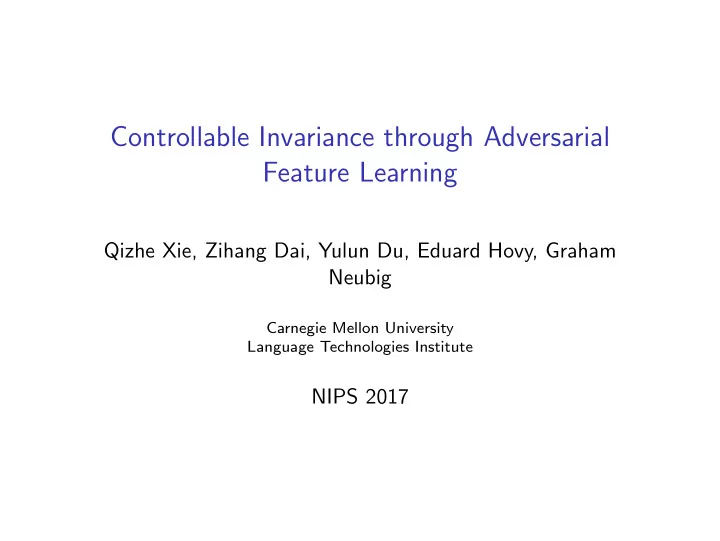

Controllable Invariance through Adversarial Feature Learning Qizhe Xie, Zihang Dai, Yulun Du, Eduard Hovy, Graham Neubig Carnegie Mellon University Language Technologies Institute NIPS 2017
Outline Introduction Introduction Adversarial Invariant Feature Learning Framework Theoretical analysis Experiments Experiments: Fairness Classifications Experiments: Multi-lingual Machine Translation Experiments: Image Classification
Introduction ◮ Representations with invariance properties are often desired ◮ Spatial invariance: CNN ◮ Temporal invariance: RNN ◮ This work: a generic framework to induce invariance to a specific factor/attribute of data ◮ Image classifications: classifying people’s identities invariant to lighting conditions ◮ Multi-lingual machine translation (fr-en, de-en): translation invariant to source language for sentences with the same meaning ◮ Fairness classifications: predicting credit and saving conditions invariant to the age, gender and race of a person
Problem formulation Task: ◮ Given input x (images, sentences or features), attribute s (can be discrete, continuous or structured) of x ◮ Predict target y ◮ Prior belief: Prediction should be invariant to s ◮ e.g., predicting identities of a person in a image. s is the lighting condition ◮ Two possible data generation processes:
Discriminative model ◮ y and s are not independent given x although they can be marginally independent (Explaining-away) ◮ p ( y | x , s ) is more accurate than p ( y | x ), i.e., knowing s helps in inferring y. ◮ “brighten” the representation if it knows the original picture is dark ◮ Encoder E : obtain the invariant representation h = E ( x , s ). ( s is used as the input of the encoder) ◮ Predictor M : Outputs q M ( y | h ) (predict y based on h )
Enforcing Invariance ◮ h is invariant to s means that � ∃ f : f ( h ) = s ◮ Employ a Discriminator D to model f : Outputs q D ( s | h ) (predict s based on h ) ◮ An adversarial game to enforce invariance: ◮ Discriminator tries to detect s from the representation ◮ Encoder learns to conceal it Two objective ◮ Standard MLE loss: min E , M − log q M ( y | h = E ( x , s )) ◮ Adversarial loss to ensure invariance: min E max D γ log q D ( s | h = E ( x , s ))
Theoretical Analysis ◮ Overall objective: min E , M max D J ( E , M , D ) where J ( E , M , D ) is E x , s , y ∼ p ( x , s , y ) [ γ log q D ( s | h = E ( x , s )) − log q M ( y | h = E ( x , s ))] ◮ Definition: ˜ � p ( h , s , y ) = x p ( x , s , y ) p E ( h | x , s ) dx ◮ Claim 1: Given an encoder, the optimal discriminator and optimal predictor: ◮ q ∗ D ( s | h ) = ˜ p ( s | h ) and q ∗ M ( y | h ) = ˜ p ( y | h ) ◮ Note that q D and q M are functions of E ◮ Claim 2: The optimal encoder is defined by:
Equilibriums Analysis ◮ The equilibrium of the minimax game is defined by min E − γ H (˜ q ( s | h )) + H (˜ q ( y | h )) ◮ Win-win equilibrium: ◮ s and y are marginally independent ◮ Two entropy terms reach the optimum at the same time ◮ e.g., removing the lighting conditions in image classifications results in better generalization ◮ Competing equilibrium: ◮ s and y are NOT marginally independent ◮ The optimal of the two entropies cannot be achieved simultaneously ◮ Filtering out s from h does harm the prediction of y ◮ e.g., removing bias in fairness classifications hurts the overall performance
Experiments: Fairness Classifications ◮ Task: Predict savings, credit and health condition based on features of a person. s can be gender or age ◮ E , M , D are all DNN Figure 1: Fair representations should lead to low accuracy on predicting factor s and high accuracy on predicting y .
Experiments: Multi-lingual Machine Translation ◮ Task: Translation from German (de) and French (fr) to English. s indicates the source language (an one-hot vector) ◮ E , M , D are all LSTM ◮ Separate encoders for different languages (Recall that h = E ( x , s )). ◮ Sharing encoder does not work ◮ DNN based discriminator (even with attention) does not work ◮ Lesson: It is important for E , M , D to have enough capacity to achieve the equilibrium Model test (fr-en) test (de-en) Bilingual Enc-Dec [Bahdanau et al., 2015] 35.2 27.3 Multi-lingual Enc-Dec [Johnson et al., 2016] 35.5 27.7 Our model 36.1 28.1 w.o. discriminator 35.3 27.6 w.o. separate encoders 35.4 27.7 Table 1: BLEU score on IWSLT 2015. The ablation study of ”w.o. discriminator” shows the improvement is not due to more parameters
Experiments: Image Classification ◮ Task: classifying identities. s is the lighting condition ◮ E, M, D are DNN Method Accuracy of classifying factor s Accuracy of classifying target y Logistic regression 0.96 0.78 NN + MMD [Li et al., 2014] - 0.82 VFAE [Louizos et al., 2016] 0.57 0.85 Ours 0.57 0.89 Table 2: Results on Extended Yale B dataset Figure 2: t-SNE visualizations of original pictures and learned representations. The original picture is clustered by lighting conditions. The learned representation is clustered by identities
Recommend
More recommend